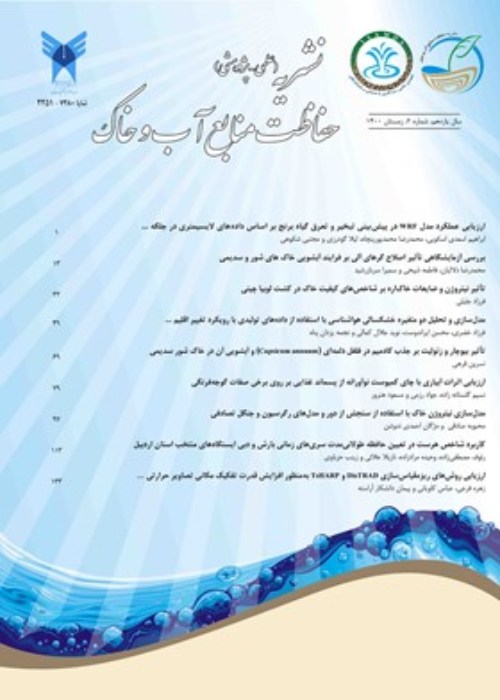The Effect of Salicylic Acid and Pseudomonas Putida Bacteria on Enzyme Properties of Quinoa Plant in Saline Soil Contaminated With Arsenic
Due to the fact that some of the country's regions, such as Khorasan Razavi, Isfahan, Kerman, etc., are contaminated with arsenic (As), and on the other hand, most of Iran's soils are associated with different degrees of salinity and few agricultural management operations like plant selection or applying organic acids such as salicylic acid (SA) have been used, therefore, this research is conducted with the following objectives 1) Investigate the effect of Pseudomonas putida (P. Putida) bacteria inoculation in soil salinity stress conditions, 2) Investigate the effect of arsenic pollution in soil salinity stress conditions, 3) Investigate the effect of salicylic acid foliar application on cultivated quinoa plant in saline soil and 4) Dual and triunal effects of experimental treatments on some quantitative and qualitative characteristics of the quinoa plant (Titicaca cultivar).
A completely randomized design (factorial), including the first factor 1) control soil (no inoculation of Pseudomonas putida bacteria, 2) inoculation of Pseudomonas putida bacteria, the second factor: two levels of arsenic (0 and 40 mg/kg) and the third factor: foliar spraying of two levels of salicylic acid (0 and 0.5 mM) in total of 24 pots with a volume of 5000 cubic centimeters were prepared to apply the desired treatments in three replications. To provide saline soil without arsenic, samples are taken from the depth of 0 to 30 cm from Areh village located 45 km of Mashhad-Sarkhos Road. After air-drying and pounding, the samples are sieved with a two-millimeter sieve, and then part of it is moved to the soil science laboratory for preliminary analysis. After preparing the soil, 4 kg of soil is transferred to each pot. Then arsenic salt (Na2AsHO4.7H2O) is added to the pots with the amount of 40 mg/kg of soil. After quinoa plant cultivation, Titicaca variety, when the plants reached the two-leaf stage, the liquid culture medium containing Pseudomonas bacteria is added in three stages (with 5 days intervals). In the following, the plants are sprayed with salicylic acid solution at the 4-leaf stage in 5 stages (with 6 days intervals). Subsequently, the parameters of photosynthetic pigments’ (Lichtenthaler, 1987) antioxidant activity, (Brand-Williams et al, 1995), proline (Bates et al, 1973) and catalase (Dhindsa et al, 1981) of plants’ new leaves are carried out in the soil science laboratory of Ferdowsi University.
The results of the analysis of variance of the triple interaction effects of arsenic × salicylic acid × bacteria illustrate that the triple interaction effect on carotenoid is significant at the level of 1% (p<0.01), and the values of chlorophyll a, proline and antioxidant activity are significant at the level of 5% (p<0.05).The results of comparing the average of the triple interaction effects of arsenic levels, salicylic acid and bacteria show that at the zero level of arsenic + spraying solution 0.5 mM salicylic acid + the presence of bacteria can have a positive and significant role on the amount of chlorophyll a (10.76 micrograms per gram of fresh weight) equivalent to +25.11% and carotenoid (3.53 μg/g fresh weight) equal to +25.17 % compared to the control samples (soil with salinity stress). Also, the presence of arsenic (40 mg/kg) + 0.5 mM salicylic acid solution spraying + the presence of bacteria caused a significant increase in proline (8.23 μg/g fresh weight) equivalent to +22.29% compared to the control samples, which demonstrates the positive effects of spraying salicylic acid and bacteria in the conditions of salinity stress with arsenic contamination in the soil. Arsenic (40 mg/kg) + 0.5 mM salicylic acid solution + the presence of bacteria shows a significant rise in the antioxidant activity of quinoa plant (45.03 μg/g fresh weight) equivalent to +47.88% compared to the control sample.
The application of Pseudomonas putida bacteria and salicylic acid can enhance the tolerance of plants against salinity stress and heavy metals by regulating the levels of different metabolites of antioxidant enzymes, secondary metabolites, and metal-chelating compounds. In this research, salicylic acid under natural soil salinity conditions (8.16 dS/m) increases chlorophyll a, carotenoid , proline , and antioxidant activity to +14%, +9.6%, +6.4% and +8.7%, respectively. On the other hand, under natural soil salinity conditions (8.16 dS/m) with 40 mg/kg of arsenic contamination in the soil, it has significantly increased plant proline equivalent to 20.65%, which led to a significant rise in antioxidant activity equivalent to +38.02%. The inoculation of Pseudomonas putida bacteria in saline soil contaminated with arsenic significantly boost proline of the plant equal to +22.29% and antioxidant activity equal to +47.88%, which greatly improved the content of chlorophyll, carotenoid and photosynthesis of quinoa plant.
- حق عضویت دریافتی صرف حمایت از نشریات عضو و نگهداری، تکمیل و توسعه مگیران میشود.
- پرداخت حق اشتراک و دانلود مقالات اجازه بازنشر آن در سایر رسانههای چاپی و دیجیتال را به کاربر نمیدهد.


